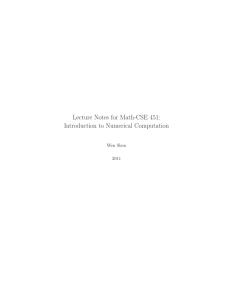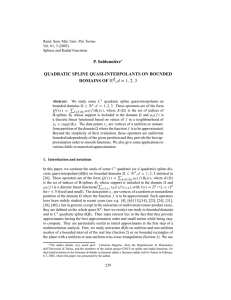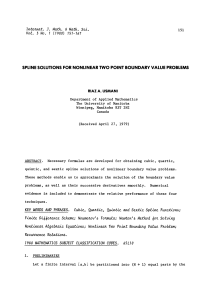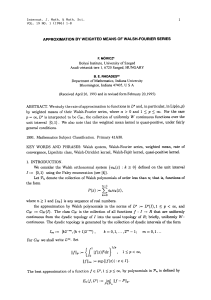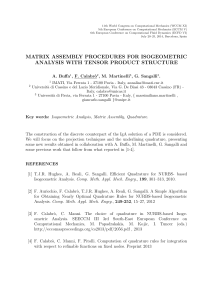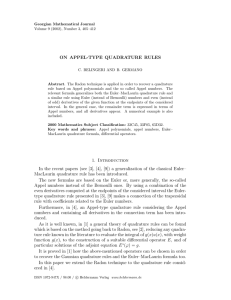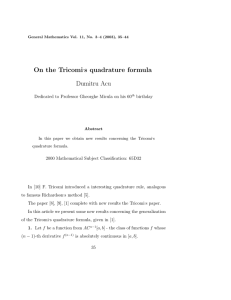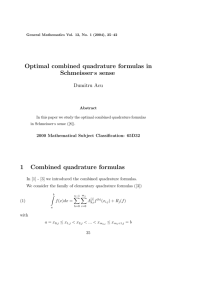SPLINE APPROXIMATION AND GENERALIZED TUR ´ AN QUADRATURES
advertisement
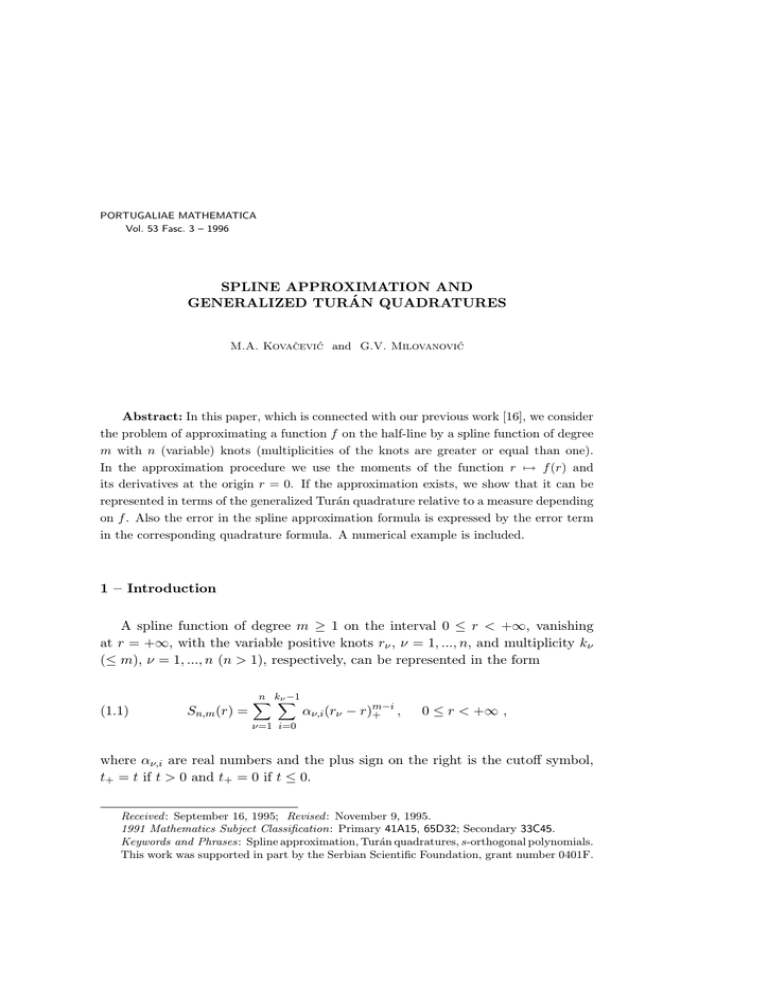
PORTUGALIAE MATHEMATICA
Vol. 53 Fasc. 3 – 1996
SPLINE APPROXIMATION AND
GENERALIZED TURÁN QUADRATURES
M.A. Kovačević and G.V. Milovanović
Abstract: In this paper, which is connected with our previous work [16], we consider
the problem of approximating a function f on the half-line by a spline function of degree
m with n (variable) knots (multiplicities of the knots are greater or equal than one).
In the approximation procedure we use the moments of the function r 7→ f (r) and
its derivatives at the origin r = 0. If the approximation exists, we show that it can be
represented in terms of the generalized Turán quadrature relative to a measure depending
on f . Also the error in the spline approximation formula is expressed by the error term
in the corresponding quadrature formula. A numerical example is included.
1 – Introduction
A spline function of degree m ≥ 1 on the interval 0 ≤ r < +∞, vanishing
at r = +∞, with the variable positive knots rν , ν = 1, ..., n, and multiplicity kν
(≤ m), ν = 1, ..., n (n > 1), respectively, can be represented in the form
(1.1)
Sn,m (r) =
n kX
ν −1
X
αν,i (rν − r)m−i
,
+
0 ≤ r < +∞ ,
ν=1 i=0
where αν,i are real numbers and the plus sign on the right is the cutoff symbol,
t+ = t if t > 0 and t+ = 0 if t ≤ 0.
Received : September 16, 1995; Revised : November 9, 1995.
1991 Mathematics Subject Classification: Primary 41A15, 65D32; Secondary 33C45.
Keywords and Phrases: Spline approximation, Turán quadratures, s-orthogonal polynomials.
This work was supported in part by the Serbian Scientific Foundation, grant number 0401F.
356
M.A. KOVAČEVIĆ and G.V. MILOVANOVIĆ
Using the following conditions
(1.2)
+∞
Z
r
j+d−1
Sn,m (r) dr =
0
+∞
Z
rj+d−1 f (r) dr ,
j = 0, 1, ..., 2(s+1)n−1 ,
0
we [16] considered the problem of approximating a function f (r) of the radial
distance r = kxk, 0 ≤ r < +∞ in IRd , d ≥ 1, by the spline function (1.1),
where kν = 2s + 1, ν = 1, ..., n, s ∈ IN0 . The work on this subject was initiated
in computational plasma physics ([1], [13]) and continued in mathematics (see
[4–10], [12], [14], [16–17]).
In this paper we discuss two similar problems of approximating a function
f (r), 0 ≤ r < +∞, by the spline function (1.1). (Let N denote the sum of the
variable knots rν , ν = 1, ..., n, of the spline function (1.1), counting multiplicities,
i.e., N = k1 + · · · + kn .)
Problem 1. Determine Sn,m in (1.1) such that
(1.3)
(k)
Sn,m
(0) = f (k) (0) ,
k = 0, 1, ..., N + n − 1, m ≥ N + n − 1 .
Problem 2. Determine Sn,m in (1.1) such that
(k)
Sn,m
(0) = f (k) (0) ,
(1.4)
k = 0, 1, ..., l (l ≤ m)
and
(1.5)
+∞
Z
j
r Sn,m (r) dr =
0
+∞
Z
rj f (r) dr ,
j = 0, 1, ..., N + n − l − 2 .
0
In Section 2 we give solutions of these problems as well as the approximation
errors. Some remarks on the generalized Gauss–Turán quadratures are given in
Section 3. Finally, a numerical example is analyzed in Section 4. An analogous
problem to Problem 2 for approximation of a function f by defective spline functions on the finite interval [0, 1] has been studied by Gori and Santi [9] and solved
by means of monosplines.
2 – Spline approximation
We first consider the Problem 2.
357
SPLINE APPROXIMATION
Theorem 2.1. Let f ∈ C m+1 [0, +∞) and
+∞
Z
rN +n−l+m |f (m+1) (r)| dr < +∞ .
(2.1)
0
Then a spline function Sn,m of the form (1.1) with positive knots rν , that satisfies
(1.4) and (1.5), exists and is unique if and only if the measure
(−1)m+1 m−l (m+1)
r
f
(r) dr
m!
admits a generalized Gauss–Turán quadrature
(2.2)
dλ(r) =
+∞
Z
g(r) dλ(r) =
(2.3)
n kX
ν −1
X
(n)
Aν,k g (k) (rν(n) ) + Rn (g; dλ) ,
ν=1 k=0
0
(n)
with n distinct positive nodes rν , where Rn (g; dλ) = 0 for all g ∈ PN +n−1 . The
(n)
knots in (1.1) are given by rν = rν , and the coefficients αν,i by the following
triangular system:
(2.4)
(n)
Aν,k
=
kX
ν −i
i=k
à !
(m−i)! i h i−k m−l i
D r
αν,i
r=rν
m!
k
(k = 0, 1, ..., kν −1) ,
where D is the standard differentiation operator.
Proof: Let j ≤ N + n − l − 2. Because of (2.1), the integral
+∞
Z
rj+m+2 f (m+1) (r) dr
0
exists and lim
r→+∞
rj+m+2 f (m+1) (r)
= 0. Then, L’Hospital’s rule implies
lim rj+m+1 f (m) (r) = 0 .
r→+∞
Continuing in this manner, we find that
(2.5)
lim rj+µ+1 f (µ) (r) = 0 ,
r→+∞
µ = m, m−1, ..., 1, 0 .
By Taylor’s formula, one has for any b > 0,
f (k) (r) = f (k) (b) + f (k+1) (b)
1
+
(m − k)!
Zr
b
(r − b)m−k
(r − b)
+ · · · + f (m) (b)
1!
(m − k)!
(r − t)m−k f (m+1) (t) dt ,
358
M.A. KOVAČEVIĆ and G.V. MILOVANOVIĆ
for k = 0, 1, ..., m. Letting b → +∞ and noting (2.5), we obtain
(2.6)
f
(k)
(−1)m−k+1
(r) =
(m − k)!
+∞
Z
(t − r)m−k f (m+1) (t) dt ,
k = 0, 1, ..., m ,
r
and, for r = 0,
(2.7)
f
(k)
+∞
Z
(−1)m−k+1
(0) =
(m − k)!
tm−k f (m+1) (t) dt ,
k = 0, 1, ..., m .
0
On the other hand, differentiating (1.1), we obtain
(2.8)
(k)
Sn,m
(0) = (−1)k
sν
n X
X
(m − i)!
rm−i−k αν,i ,
(m − i − k)! ν
ν=1 i=0
k = 0, 1, ..., m ,
where sν = min(m − k, kν − 1), ν = 1, ..., n.
Substituting (2.7) and (2.8) in (1.4), we find
sν
n X
X
(m − i)!
ν=1 i=0
m!
αν,i
+∞
Z
(m − k)!
rm−i−k =
(m − i − k)! ν
0
(−1)m+1 m−k (m+1)
r
f
(r) dr
m!
or
(2.9)
n kX
ν −1
X
(m − i)!
ν=1 i=0
h
i m−k
αν,i D r
m!
i
+∞
Z
=
r=rν
0
(−1)m+1 m−k (m+1)
r
f
(r) dr ,
m!
for k = 0, 1, ..., l, where D is the standard differentiation operator.
The conditions (2.9) can be represented in the form
n kX
ν −1
X
(m − i)!
ν=1 i=0
m!
h
i
αν,i D (r
m−l j
r )
i
r=rν
=
+∞
Z
0
(−1)m+1 m−l (m+1)
r
f
(r) rj dr,
m!
j = 0, 1, ..., l ,
or, after the application of Leibniz’s formula to the i-th derivative,
n kX
ν −1
X
(2.10)
ν=1 k=0
(n)
(n)
Aν,k
h
k j
D r
i
r=rν
=
+∞
Z
rj dλ(r) ,
0
where Aν,k and dλ(r) are given by (2.4) and (2.2).
j = 0, 1, ..., l ,
359
SPLINE APPROXIMATION
Now, we consider the conditions (1.5).
Using (1.1) and observing that rν > 0, we have
+∞
Z
j
r Sn,m (r) dr =
n kX
ν −1
X
αν,i
ν=1 i=0
0
Zrν
rj (rν − r)m−i dr .
0
Changing variables, r = trν , in the integral on the right, we obtain the well-known
beta integral, which can be expressed in terms of factorials. So we find
+∞
Z
rj Sn,m (r) dr =
n kX
ν −1
X
j!(m − i)!
αν,i rνj+m−i+1
(j + m − i + 1)!
ν=1 i=0
0
or
(2.11)
+∞
Z
n kX
ν −1
h
i
X
j!
r Sn,m (r) dr =
(m − i)! αν,i Di rj+m+1
.
r=rν
(j + m + 1)! ν=1 i=0
0
j
Through m + 1 integrations by parts and noting (2.5), the integral on the
right of (1.5) can be transformed to
(2.12)
+∞
Z
0
(−1)m+1
r f (r) dr =
(j +1) (j +2) · · · (j +m+1)
j
=
+∞
Z
rj+m+1 f (m+1) (r) dr
0
+∞
Z
(−1)m+1 j!
(j + m + 1)!
rj+m+1 f (m+1) (r) dr .
0
The conditions (1.5) now become
n kX
ν −1
X
(m − i)!
m!
ν=1 i=0
h
i m+j+1
αν,i D r
i
=
r=rν
+∞
Z
0
(−1)m+1 m+j+1 (m+1)
r
f
(r) dr ,
m!
i.e.,
n kX
ν −1
X
(m−i)!
ν=1 i=0
m!
h
i m−l j+l+1
αν,i D r
r
i
=
r=rν
+∞
Z
0
(−1)m+1 m−l (m+1)
r
f
(r) rj+l+1 dr ,
m!
where j = 0, 1, ..., N + n − l − 2. After the application of Leibniz’s formula to the
i-th derivative on the left side of the above equation, we get
(2.13)
n kX
ν −1
X
ν=1 k=0
(n)
Aν,k
h
k j+l+1
D r
i
r=rν
=
+∞
Z
rj+l+1 dλ(r) ,
0
360
M.A. KOVAČEVIĆ and G.V. MILOVANOVIĆ
(n)
where j = 0, 1, ..., N + n − l − 2, and Aν,k and dλ(r) are given by (2.4) and (2.2),
respectively.
Finally, (2.10) and (2.13) yield
(2.14)
n kX
ν −1
X
(n)
Aν,k
ν=1 k=0
h
k j
D r
i
r=rν
=
+∞
Z
rj dλ(r) ,
j = 0, 1, ..., N +n−1 .
0
Hence, we conclude that Eqs. (1.4) and (1.5) are equivalent to Eqs. (2.14). These
are precisely the conditions for rν to be the nodes of the generalized Gauss–
(n)
(n)
Turán quadrature formula (2.3) (rν = rν ) and Aν,k , determined by (2.14), their
coefficients.
Remark 2.1. If we let l = N + n − 1, the Theorem 2.1 gives the solution
of Problem 1. Namely, equating (2.7) and (2.8), for k = 0, 1, ..., N + n − 1
(m ≥ N + n − 1), we obtain (2.14), where l = N + n − 1.
Remark 2.2. The case k1 = k2 = · · · = kn = 1, l = −1, of Theorem 2.1 has
been obtained in [8].
Similarly as in [16], we can prove the following result regarding the approximating error.
Theorem 2.2. Let f be given as in Theorem 2.1 and such that the measure
dλ in (2.2) admits a generalized Gauss–Turán quadrature formula (2.3) with
(n)
distinct positive nodes rν = rν . Define
σr (t) = t−(m−l) (t − r)m
+ .
Then the error of the spline approximation (1.1), (1.3) (l = N + n − 1) or (1.1),
(1.4), (1.5), is given by
(2.15)
f (r) − Sn.m (r) = R(σr (t); dλ(t)) ,
r>0,
where R(σr (t); dλ(t)) is the remainder term in the formula (2.2)–(2.3)
(2.16)
+∞
Z
g(t) dλ(t) =
n kX
ν −1
X
(n)
Aν,k g (k) (rν(n) ) + R(g(t); dλ(t)) .
ν=1 k=0
0
Proof: Using (2.6) for k = 0, we find
(−1)m+1
f (r) =
m!
+∞
Z
m
(t − r) f
r
(m+1)
(−1)m+1
(t) dt =
m!
+∞
Z
(m+1)
(t − r)m
(t) dt ,
+ f
0
361
SPLINE APPROXIMATION
i.e.,
(2.17)
+∞
Z
f (r) =
σr (t) dλ(t) .
0
On the other hand, we consider the sum
Fν (r) =
kX
ν −1
(n)
h
Aν,k Dk σr (t)
k=0
i
t=rν
,
(n)
where Aν,k are the coefficientes of the generalized Gauss–Turán quadrature (2.16).
By (2.4) and Leibniz’s formula, we obtain
Fν (r) =
=
=
=
=
kX
ν −1h
k=0
kX
ν −1
i=0
kX
ν −1
i=0
kX
ν −1
i=0
kX
ν −1
k
D σr (t)
i
kX
ν −1
t=rν
(m − i)!
αν,i
m!
i=k
i
X
k=0
à !
(m − i)! i h i−k m−l i
D t
αν,i
t=rν
m!
k
à !
o
i n k
[D σr (t)][Di−k tm−l ]
t=rν
k
i
(m − i)!
αν,i Di (tm−l σr (t))
t=rν
m!
h
h
i
(m − i)!
αν,i Di (t − r)m
+
t=rν
m!
αν,i (rν − r)m−i
,
+
i=0
i.e.,
n
X
(2.18)
Fν (r) = Sn,m (r) .
ν=1
Finally, using (2.17) and (2.18), we obtain (2.15).
3 – On the generalized Gauss-Turán quadratures
The generalized Gauss–Turán quadratures with a given nonnegative measure
dλ(r) on the real line IR (with compact or infinite support for which all moments
R
µi = IR ri dλ(r), i = 0, 1, ..., exist and are finite, and µ0 > 0),
(3.1)
Z
g(r) dλ(r) =
IR
n m−1
X
X
ν=1 k=0
Aν,k g (k) (rν ) + Rn (g; dλ)
362
M.A. KOVAČEVIĆ and G.V. MILOVANOVIĆ
is exact for all polynomials of degree at most (m + 1)n − 1, if m is odd, i.e.,
m = 2s + 1 (see [19]). The nodes rν , ν = 1, ..., n, are the zeros of the (monic)
polynomial πn minimizing
Z
(3.2)
IR
[πn (r)]2s+2 dλ(r) .
Such polynomials are known as power-orthogonal (s-orthogonal or s-self associated) polynomials with respect to the measure dλ(r). For a given n and s, the
minimization of the integral (3.2) leads to the “orthogonality conditions”
Z
(3.3)
IR
πn (r)2s+1 ri dλ(r) ,
i = 0, 1, ..., n−1 ,
which can be interpreted as (see [15])
Z
(3.4)
IR
πνs,n (r) ri dµ(r) = 0 ,
i = 0, 1, ..., ν −1 ,
where {πνs,n } is a sequences of monic orthogonal polynomials with respect to the
new measure dµ(r) = dµs,n (r) = (πns,n (r))2s dλ(r). As we can see, the polynomials
πνs,n , ν = 0, 1, ..., are implicitly defined because the measure dµ(r) depends on
πns,n (= πn (r)). Of course, we are interested only in πns,n (r). A stable procedure
of constructing such polynomials (s-orthogonal) is given in [15].
A generalization of the formula (3.1) to rules having nodes with arbitrary
multiplicities was given, independently, by Chakalov [2–3] and Popoviciu [18].
Let σ = (s1 , s2 , ..., sn ) be a sequence of nonegative integers. In this case, it is
important to assume that the nodes rν are ordered, say
a ≤ r 1 < r2 < · · · < r n ≤ b ,
with odd multiplicities 2s1 + 1, ..., 2sn + 1, respectively. Here [a, b] is the support
of the measure dλ(r). Then the coresponding quadrature formula
Z
(3.5)
g(r) dλ(r) =
IR
2sν
n X
X
Aν,k g (k) (rν ) + Rn (g; dλ)
ν=1 k=0
has the maximum degree of exactness dmax = 2
(3.6)
Z
n
Y
IR ν=1
(r − rν )2sν +1 ri dλ(r) = 0 ,
n
P
sν + 2n − 1, if and only if
ν=1
i = 0, 1, ..., n−1 .
The last “orthogonality conditions” correspond to (3.3).
363
SPLINE APPROXIMATION
If we put
(n)
πk,σ (r)
=
k
Y
(r − rν(k) ) ,
(k)
(k)
a ≤ r1 < · · · < r k ≤ b ,
ν=1
and
dµ(r) =
n
Y
(r − rν(n) )2sν dλ(r)
(rν(n) ≡ rν , ν = 1, ..., n) ,
ν=1
then the “orthogonality conditions’’ (3.6) can be interpreted as
Z
(n)
IR
πk,σ (r) ri dµ(r) = 0 ,
i = 0, 1, ..., k−1 .
(n)
So we conclude that {πk,σ } is a sequence of (standard) orthogonal polynomials
(n)
with respect to the measure dµ(r). The polynomials πn,σ are called σ-orthogonal
polynomials. An algorithm for constructing them is given in [11].
If we have sν = s, ν = 1, ..., n, the above polynomials reduce to the
s-orthogonal polynomials.
If we find the nodes (rν , ν = 1, ..., n) of the generalized Gauss–Turán quadrature formula (3.1) or (3.5) (the zeros of the s-orthogonal polynomial π ns,n or σ(n)
orthogonal polynomial πn,σ , respectively), then their coefficients are determined
from the linear system equations (3.1) or (3.5), for g(r) = r i (Rn (ri , dλ) = 0),
where i = 0, 1, ..., 2(s + 1)n − 1 or i = 0, 1, ..., dmax , respectively.
4 – Numerical example
If in the spline function (1.1) we take kν = 2s + 1, ν = 1, ..., n, s ∈ IN0 , i.e.,
(4.1)
Sn,m (r) =
n X
2s
X
αν,i (rν − r)m−i
,
+
0 ≤ r < +∞ ,
ν=1 i=0
and l is formally replaced by −d in Theorem (2.1), in view of the approximative
requirement (1.2), then we get the identical statement as in [16, Theorem 2.1].
Therefore, this fact enables us in this case to use the previously developed software
for the problem (1.2). Now, for solving problems (1.3) or (1.4)–(1.5), one can take
d := −l.
Let f (r) = e−r on [0, +∞). For this function the measure (2.2) becomes the
generalized Laguerre measure
dλ(r) =
1 m−l −r
r
e dr ,
m!
0 ≤ r < +∞ .
364
M.A. KOVAČEVIĆ and G.V. MILOVANOVIĆ
First, for a given (n, s, m, l), we determine rνn (the zeros of the polynomial πns,n )
and the weight coefficients of the Turán quadrature (2.3). Then, the knots in
(n)
(3.1) are given by rν = rν , ν = 1, ..., n, and we find the coefficients of the spline
function (4.1) using the triangular system of equations (2.4).
In Tables 3.1 and 3.2 we can see the behavior of approximate values of the
(l)
resulting maximum absolute errors en,m = max |Sn,m (r) − f (r)|, for differ0≤r≤rn
ent values of (n, s, m, l). (Numbers in parenthesis indicate decimal exponents.)
Clearly, for r ≥ rn , the absolute error is equal to f (r).
Table 3.1 – Accuracy of the spline approximation for s = 1.
n
2
3
4
5
m=2
1.5(−1)
8.4(−2)
5.1(−2)
3.3(−2)
l=0
m=3
1.8(−2)
1.3(−2)
8.1(−3)
5.1(−3)
m=4
4.9(−3)
2.5(−3)
1.2(−3)
6.2(−4)
m=2
1.5(−1)
6.7(−2)
4.1(−2)
3.0(−2)
l=1
m=3
2.6(−2)
1.3(−2)
7.1(−3)
4.0(−3)
m=4
6.4(−3)
2.3(−3)
9.2(−4)
5.2(−4)
l=2
m=3 m=4
3.0(−2) 6.5(−3)
1.1(−2) 1.9(−3)
4.8(−3) 8.6(−4)
4.0(−3) 6.1(−4)
Table 3.2 – Accuracy of the spline approximation for m = 8.
n
6
7
8
9
10
l=0
s=1
s=2
2.37(−6) 1.24(−6)
1.08(−6) 5.31(−7)
5.62(−7) 2.62(−7)
3.20(−7) 1.88(−7)
2.01(−7) 1.31(−7)
l=4
s=1
s=2
2.10(−6) 1.24(−6)
1.00(−6) 6.73(−7)
5.13(−7) 3.59(−7)
2.85(−7) 1.93(−7)
1.80(−7) 1.07(−7)
REFERENCES
[1] Calder, A.C. and Laframboise, J.G. – Multiple-water-bag simulation of inhomogeneous plasma motion near an electrode, J. Comput. Phys., 65 (1986), 18–45.
[2] Chakalov, L. – General quadrature formulae of Gaussian type, Bulgar. Akad.
Nauk Izv. Mat. Inst., 1 (1954), 67–84 (Bulgarian).
SPLINE APPROXIMATION
365
[3] Chakalov, L. – Formules générales de quadrature mécanique du type de Gauss,
Colloq. Math., 5 (1957), 69–73.
[4] Frontini, M., Gautschi, W. and Milovanović, G.V. – Moment-preserving
spline approximation on finite intervals, Numer. Math., 50 (1987), 503–518.
[5] Frontini, M. and Milovanović, G.V. – Moment-preserving spline approximation on finite intervals and Turán quadratures, Facta Univ. Ser. Math. Inform., 4
(1989), 45–56.
[6] Gautschi, W. – Discrete approximations to spherically symmetric distributions,
Numer. Math., 44 (1984), 53–60.
[7] Gautschi, W. – Spline approximation and quadrature formulae, Atti Sem. Mat.
Fis. Univ. Modena, 29 (1991), 47–60.
[8] Gautschi, W. and Milovanović, G.V. – Spline approximations to spherically
symmetric distributions, Numer. Math., 49 (1986), 111–121.
[9] Gori, L. and Santi, E. – Moment-preserving approximations: a monospline
approach, Rend. Mat., 12(7) (1992), 1031–1044.
[10] Gori, L., Amati, N. and Santi, E. – On a method of approximation by means
of spline functions, in “Approximation, Optimization and Computing – Theory
and Application” (A.G. Law and C.L. Wang, Eds.), IMACS, Dalian, China, 1990,
pp. 41–46.
[11] Gori, L., Lo Cascio, M.L. and Milovanović, G.V. – The σ-orthogonal polynomials: a method of construction, in “IMACS Annals on Computing and Applied Mathematics”, Vol. 9, “Orthogonal Polynomials and Their Applications” (C.
Brezinski, L. Gori, and A. Ronveaux, Eds.), J.C. Baltzer AG, Scientific Publ. Co.,
Basel, 1991, pp. 281–285.
[12] Kovačević, M.A. and Milovanović, G.V. – Spline approximation on the halfline, in “VI Conference on Applied Mathematics” (Tara, 1988), Univ. Belgrade,
Belgrade, 1989, pp. 88–95.
[13] Laframboise, J.G. and Stauffer, A.D. – Optimum discrete approximation of
the Maxwell distribution, AIAA J., 7 (1969), 520–523.
[14] Micchelli, C.A. – Monosplines and moment preserving spline approximation, in
“Numerical Integration III” (H. Brass and G. Hämmerlin, Eds.), Birkhäuser, Basel,
1988, pp. 130–139.
[15] Milovanović, G.V. – Construction of s-orthogonal polynomials and Turán quadrature formulae, in “Numerical Methods and Approximation Theory III” (Niš,
1987) (G.V. Milovanović, Ed.), Univ. Niš, Niš, 1988, pp. 311–328.
[16] Milovanović, G.V. and Kovačević, M.A. – Moment-preserving spline approximation and Turán quadratures, in “Numerical Mathematics” (Singapore, 1988),
INSM Vol. 86 (R.P. Agarwal, Y.M. Chow and S.J. Wilson, Eds.), Birkhäuser, Basel,
1988, pp. 357–365.
[17] Milovanović, G.V. and Kovačević, M.A. – Moment-preserving spline approximation and quadratures, Facta Univ. Ser. Math. Inform., 7 (1992), 85–98.
[18] Popoviciu, T. – Sur une généralisation de la formule d’integration numérique de
Gauss, Acad. R.P. Romine Fil. Iaşi Stud. Cerc. Şti., 6 (1955), 29–57.
[19] Turán, P. – On the theory of the mechanical quadrature, Acta Sci. Math. (Szeged),
12 (1950), 30–37.
366
M.A. KOVAČEVIĆ and G.V. MILOVANOVIĆ
Milan A. Kovačević and Gradimir V. Milovanović,
Faculty of Electronic Engineering, Department of Mathematics,
P.O. Box 73, 18000 Niš – YUGOSLAVIA
E-mail: gradeefnis.elfak.ni.ac.yu
